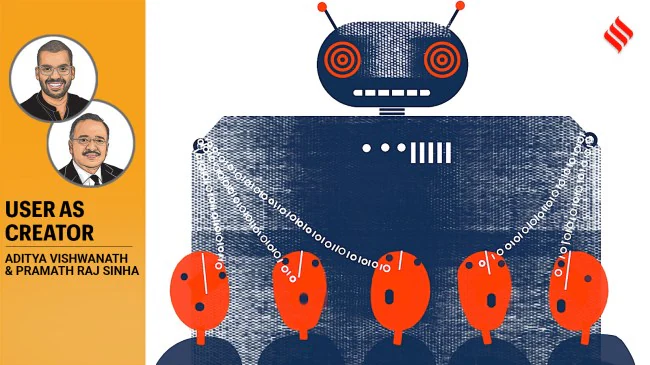26 April 2025 Indian Express Editorial
What to Read in Indian Express Editorial( Topic and Syllabus wise)
Editorial 1 : User as Creator
Context: We can’t just be users of AI; we have to be its co-creators.
Introduction: India contributes 16% of global AI talent and has the fastest -growing developer population worldwide. AI skill penetration in India surpasses the US and Germany.
Homegrown Innovations
- Indigenous AI models like Sarvam-1 (11 Indian languages) and Hanooman (12 languages).
- IndiaAI Mission: Focus on infrastructure expansion, research, and accessibility.
Key Challenges
- Digital Divide
- Urban vs. rural disparity: Tools like chatbots fail to address dialects (e.g., Shabnam, a Mumbai health worker).
- Assumptions of digital fluency in interfaces exclude non-tech-savvy users.
- Contextual Irrelevance
- AI recommendations lack local context (e.g. pricing apps for vendors, credit systems for self-help groups).
- Data biases: Models trained on internet-scraped data ignore India’s linguistic and cultural pluralism.
- Top-Down Deployment: Tools prioritize availability over usable access, reinforcing exclusion.
Redefining AI Literacy as a Democratic Right
- Shifting the Narrative
- From Technical Skills to Critical Agency
- Focus on enabling citizens to question AI systems: Who built it? For whom? With what consequences?
- Example: Vegetable vendors assessing fairness of AI pricing apps.
- Situated Literacy: Root AI education in local needs (e.g. workflows of nurses, farmers, gig workers).
- From Technical Skills to Critical Agency
- Past Success: India’s Digital Finance Revolution
- The digital finance revolution relied on community intermediaries (bank sakhis, WhatsApp groups) to build trust and usability.
- This suggests a need for AI ambassadors to bridge tech-community gaps.
Current Initiatives and Gaps
- Progress in Language and Skill Development
- Language Support: Sarvam-1 and Hanooman cover 11–12 languages but miss hundreds of dialects.
- Skill Programs: Microsoft’s goal to train 10 million Indians in AI/cloud skills by 2030.
- Limitations
- Data Representation: Most datasets lack hyper-local context (accents, customs, knowledge systems).
- Inclusive Design: Tools remain urban-centric, excluding rural and non-English speakers.
Way Forward: Recommendations for Inclusive AI Development
- Co-Creation with Communities: Engage teachers, municipal staff, and NGOs to build datasets reflecting India’s diversity.
- Hyper-Local Tools: Develop AI for specific workflows (e.g. farm labourer advisories, healthcare translations).
- AI Ambassadors: Train community liaisons to demystify AI and gather feedback.
- Feedback Loops: Allow users to shape AI evolution (e.g. iterative improvements based on vendor/farmer input).
- Inclusive Dissemination: Prioritize transparency in AI design and data sourcing.
- Algorithmic Accountability: Reject neutrality myths, audit the AI tools for bias and fairness.
Conclusion: There is a growing need to treat AI literacy as a movement, not a curriculum. Success hinges on trust, community collaboration, and bottom-up innovation. India must transition from being AI users to co-creators, ensuring tools serve all citizens equitably.
Editorial 2 : Missing the Shot
Context: Vaccination challenges around the world.
Introduction: Vaccines introduced in the late 18th century have drastically reduced infectious disease mortality. Development of Covid vaccines within a year of the pandemic highlighted scientific progress.
Current Challenges in Global Immunization
- Declining Immunization Efforts
- Global Slackening: Immunization drives have slowed, even in developed nations.
- Outbreaks Resurgence
- Measles: 61 countries reported outbreaks in 2023–24. The U.S. faces its first outbreak since 2000.
- Meningitis: 1,400 deaths across 24 countries in 2024.
- Yellow Fever & Other Diseases: WHO, UNICEF, and Gavi warn of increasing preventable disease outbreaks.
- Funding Crisis
- Impact on Agencies: WHO, UNICEF, and Gavi face financial constraints, limiting vaccination programs in poor countries and conflict zones like Gaza.
- U.S. Funding Cuts: Centres for Disease Control and Prevention (CDC’s) budget reductions led to the termination of the world’s largest Covid vaccine safety study (Global Vaccine Data Centre project).
Case Study: United States
- Declining Vaccination Rates
- Post-Pandemic Drop: Slight decrease in immunization rates for measles, polio, whooping cough, and chickenpox.
- Herd Immunity Loss: Pockets of unvaccinated kindergarteners (e.g. Alaska: 10% vaccination rate drop in 2 years).
- Political & Misinformation Challenges
- Trump-Era Policies: Anti-vaccine sentiment surged during Trump’s presidency.
- Robert Kennedy’s Role: Vaccine-sceptic U.S. health secretary criticized for spreading misinformation.
Consequences of Inaction
- Global Health Risks: Resurgence of preventable diseases threatens progress made over centuries.
- Fragmented Efforts: Over-reliance on single donors (e.g. U.S. withdrawal from WHO) jeopardizes global coordination.
Way Forward
- Diversify Funding: Engage governments, corporations, and philanthropic groups to fill financial gaps.
- Combat Misinformation: Strengthen public health communication to counter anti-vaccine narratives.
- Rebuild Trust: Restore funding to agencies like the CDC and WHO to ensure long-term immunization programs.
Conclusion: The fight against infectious diseases requires sustained global collaboration, robust funding, and proactive measures to counter misinformation. Without urgent action, humanity risks losing decades of public health gains.


